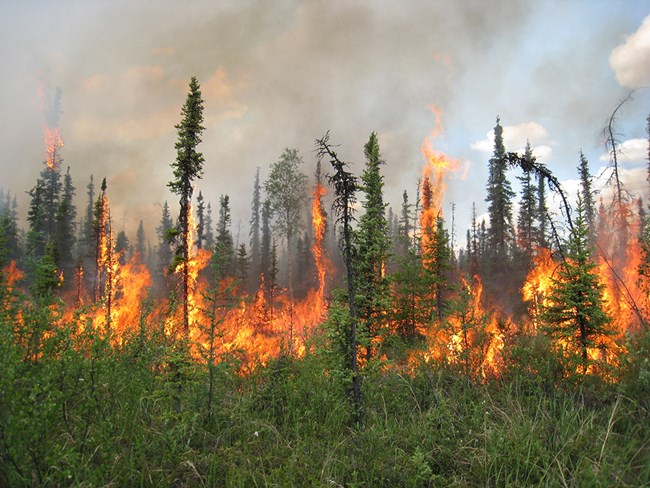Last updated: November 27, 2023
Article
Boreal forest ecology and wildland fire fuel treatments

Alaska Climate Science Center
As the climate continues to warm and boreal forests experience drying conditions, wildfire activity is increasing. Interior Alaska has extensive black spruce forests that are highly flamable and put communities at risk. Fuel reduction treatments are often used to reduce the risk of harm, but little long-term (decadal) empirical evidence exists that describes how ecosystem characteristics and fire behavior change as a result.
In this study, scientists measured a network of different aged, thinned, and shearbladed sites that were treated about 20 years ago. They documented how successional trajectories of tree dominance, understory composition, and permafrost active layer depth changed over time.
What they found was:
- Patchy disturbance to the soil organic layer in thinned treatment areas can promote the establishment of conifer seedlings. This can lead to conifer infilling over time.
- In areas that were treated with shearblading, conifer recruitment was slow and deciduous tree seedlings were 20 times more abundant, which leads to stand conversion from conifers to deciduous trees.
- The active layer depth increased over time in all treated areas, but was greater in shearbladed areas. This indicates that thinning has less impact on permafrost degration than shearblading.
- Treatment effectiveness in reducing fire behavior over time remains uncertain. There is a need for fuel type characterizations and fuel models to consider these ecological changes.
Decadal impacts of wildfire fuel reduction treatments on ecosystem characteristics and fire behavior in alaskan boreal forests
Abstract
Wildfire activity is increasing in boreal forests as climate warms and dries, increasing risks to rural and urban communities. In black spruce forests of Interior Alaska, fuel reduction treatments are used to create a defensible space for fire suppression and slow fire spread. These treatments introduce novel disturbance characteristics, making longer-term outcomes on ecosystem structure and wildfire risk reduction uncertain. We remeasured a network of sites where fuels were reduced through hand thinning or mechanical shearblading in Interior Alaska to assess how successional trajectories of tree dominance, understory composition, and permafrost change over ∼ 20 years after treatment. We also assessed if these fuel reduction treatments reduce modeled surface rate of fire spread (ROS), flame length, and fireline intensity relative to an untreated black spruce stand, and if surface fire behavior changes over time. In thinned areas, soil organic layer (SOL) disturbance promoted tree seedling recruitment but did not change over time. In shearbladed sites, by contrast, both conifer and broad-leaved deciduous seedling density increased over time and deciduous seedlings were 20 times more abundant than spruce. Thaw depth increased over time in both treatments and was greatest in shearbladed sites with a thin SOL. Understory composition was not altered by thinning but in shearbladed treatments shifted from forbs and horsetail to tall deciduous shrubs and grasses over time. Modeled surface fire behavior was constant in shearbladed sites. This finding is inconsistent with expert opinion, highlighting the need for additional fuels-specific data to capture the changing vegetation structure. Treatment effectiveness at reducing modeled surface ROS, flame length, and fireline intensity depended on the fuel model used for an untreated black spruce stand, pointing to uncertainties about the efficacy of these treatments at mitigating surface fire behavior. Overall, we show that fuel reduction treatments can promote low flammability, deciduous tree dominated successional trajectories, and that shearblading has strong effects on understory composition and permafrost degradation that persist for nearly two decades after disturbance. Such factors need to be considered to enhance the design, management, and predictions of fire behavior in these treatments.
Boyd, M. A., X. J. Walker, J. Barnes, G. Celis, S. J. Goetz, J. F. Johnstone, N. T. Link, A. M. Melvin, L. Saperstein, E. A. G. Shuur, and M. C. Mack. 2023. Decadal impacts of wildfire fuel reduction treatments on ecosystem characteristics and fire behavior in Alaskan boreal forests. Forest Ecology and Management 546: 121347.
